Source
Do you wish your Facebook ads had a higher conversion rate? Looking for proven copywriting techniques that works?
In this article, you’ll discover how to write Facebook ads that move people to action—whether you want to generate leads, secure sales, or get prospects to take other key steps.
Technically, you could squeeze an entire blog post into the primary text section of your Facebook ad. Although Ads Manager gives you a ton of space to work with, it’s often better to keep your ad copy as concise as possible.
For most ad types, Meta recommends keeping primary text copy to 125 characters. The platform recommends keeping both the headline and the description to fewer than 30 characters.
Keep in mind that longer Facebook advertising copy gets buried behind a See More link. In fact, Facebook truncates primary text copy after about 115 characters. When you build campaigns in Ads Manager, use the ad preview to see how the copy will display for each placement. If it appears truncated, consider reworking it to display in full.
For example, the @repurpose Facebook ad below uses concise copy. Because it’s short and sweet, the primary text displays in full. To get the message across, the sustainable tableware brand uses other opportunities—including the headline and the video—to share features and CTAs.
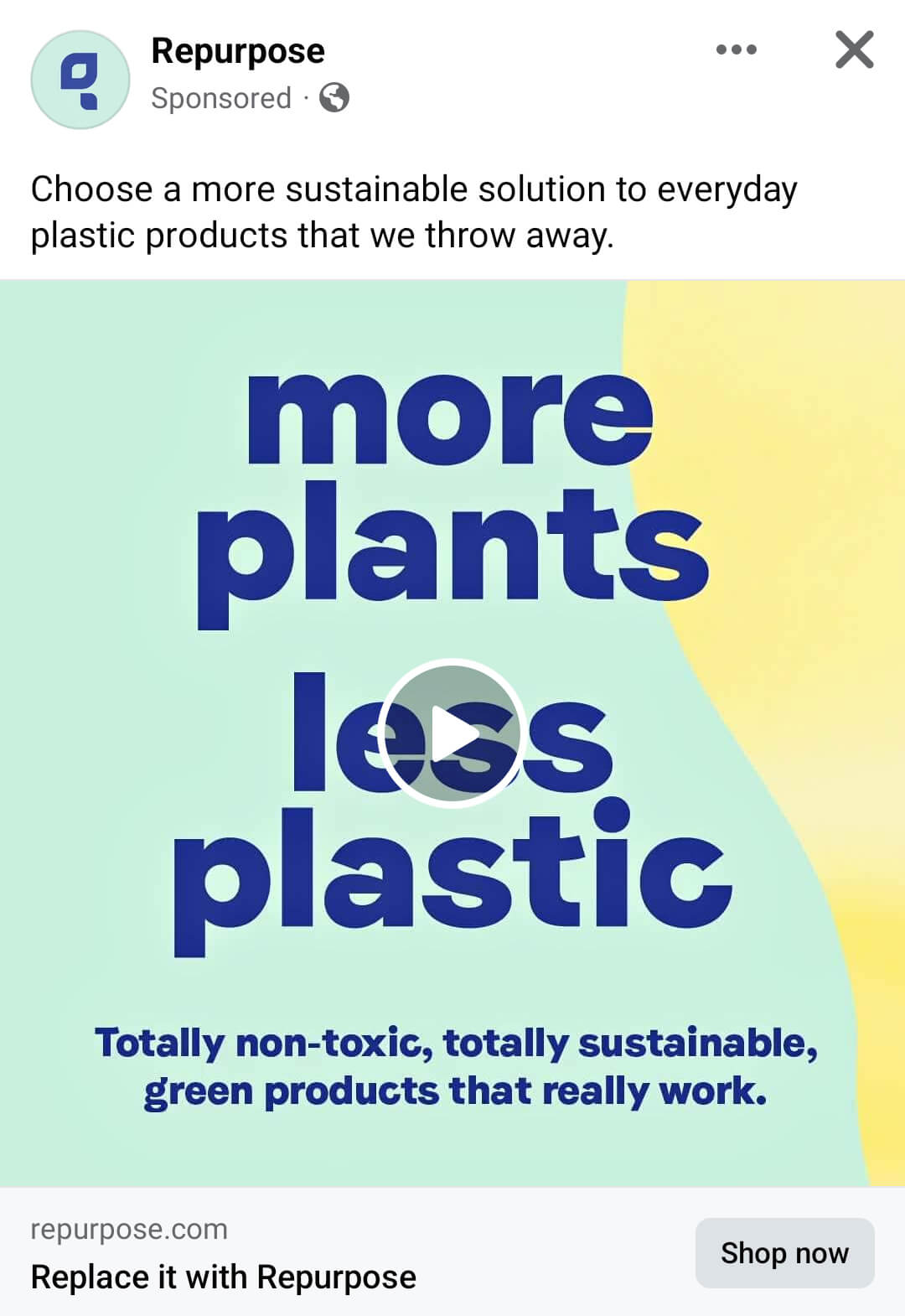
With a compelling hook, you can instantly draw in Facebook users, get them to read your message, and encourage them to act. Without a hook, your ad copy doesn’t give prospects a reason to keep reading, which can cause them to scroll past before getting to the sales pitch.
So how can you write irresistible hooks for your Facebook ads? Here are some ideas to test in your ad copy:
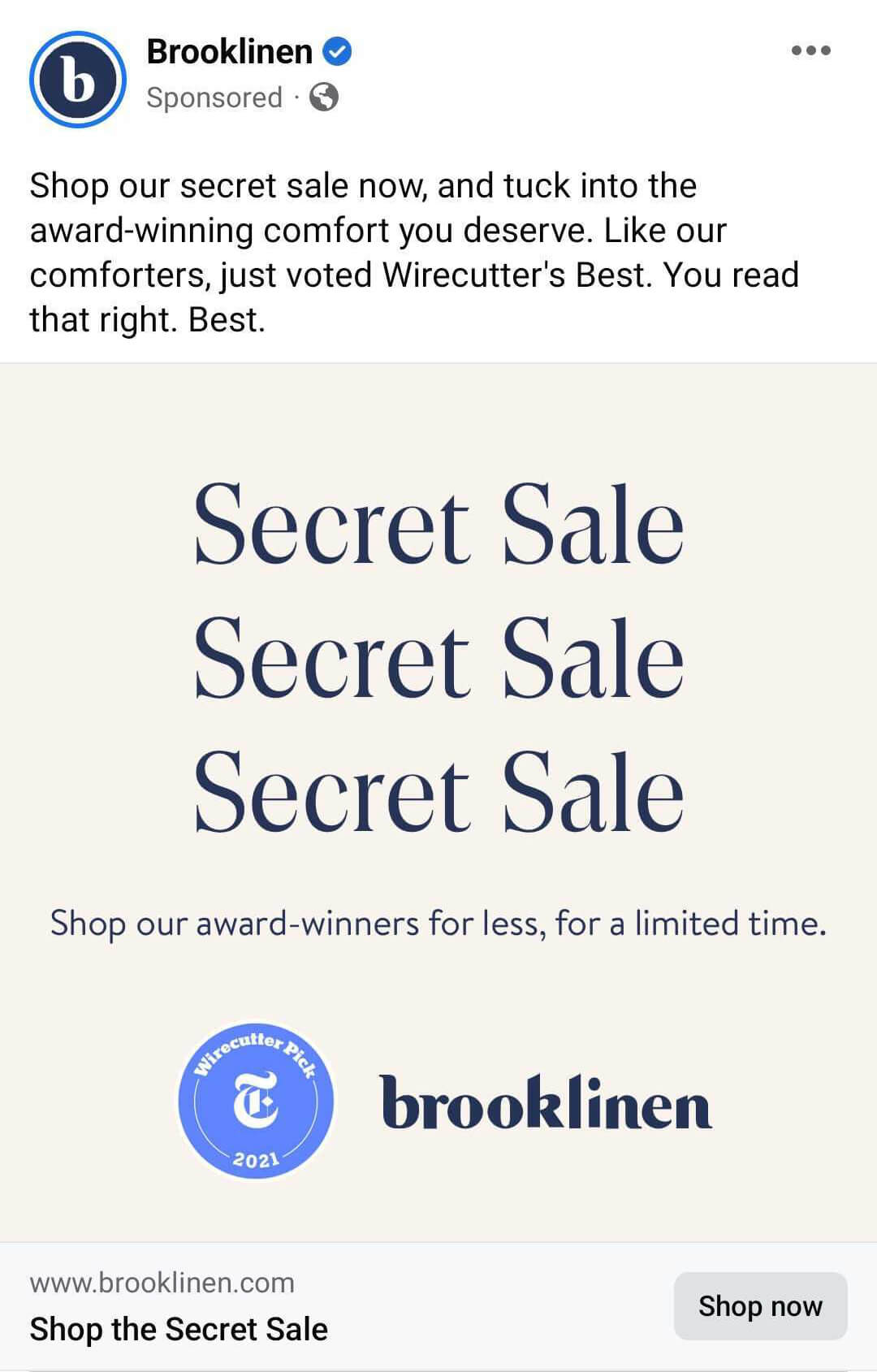
To increase conversions, create a sense of urgency. By highlighting the limited timeframe for the offer or the limited quantity available, you can urge prospects to act right away, even if they didn’t necessarily intend to buy immediately.
With limited-time or limited-quantity offers, you can also instill a fear of missing out (FOMO). If prospects believe that your product or service can solve their problems or improve their quality of life, they won’t want to miss out on your offer.
For example, the @GetRocketbook Facebook ad below makes urgency front and center in its opening line, “Limited Time Offer.” To increase conversions, the ad also mentions a generous discount and a free item with a minimum purchase.
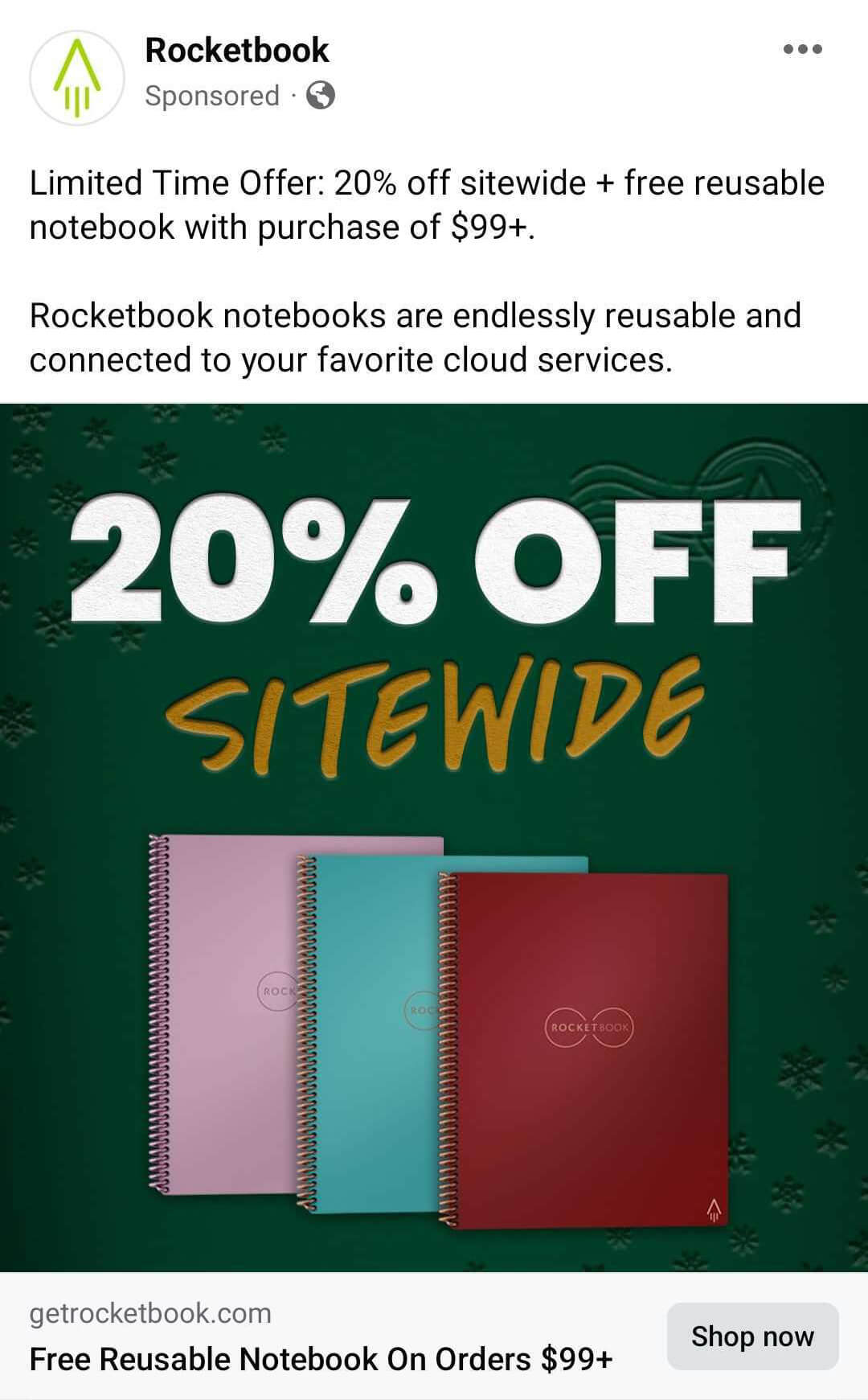
With the Problem-Agitate-Solve (PAS) copywriting formula, you can start by speaking to customers’ pain points. Then once they’re listening, you can offer a solution to these common problems.
To use the PAS formula, start by asking a question that your audience is likely to find relatable. Next, agitate the problem and the related discomfort by getting more specific. Then present your solution.
In the Facebook ad below, @onsentowel starts by asking, “Hate using wet towels?” The copy leans into the problem by referencing “musty towels.” Then it offers a solution and lists some product features and benefits to guide prospects to shop.
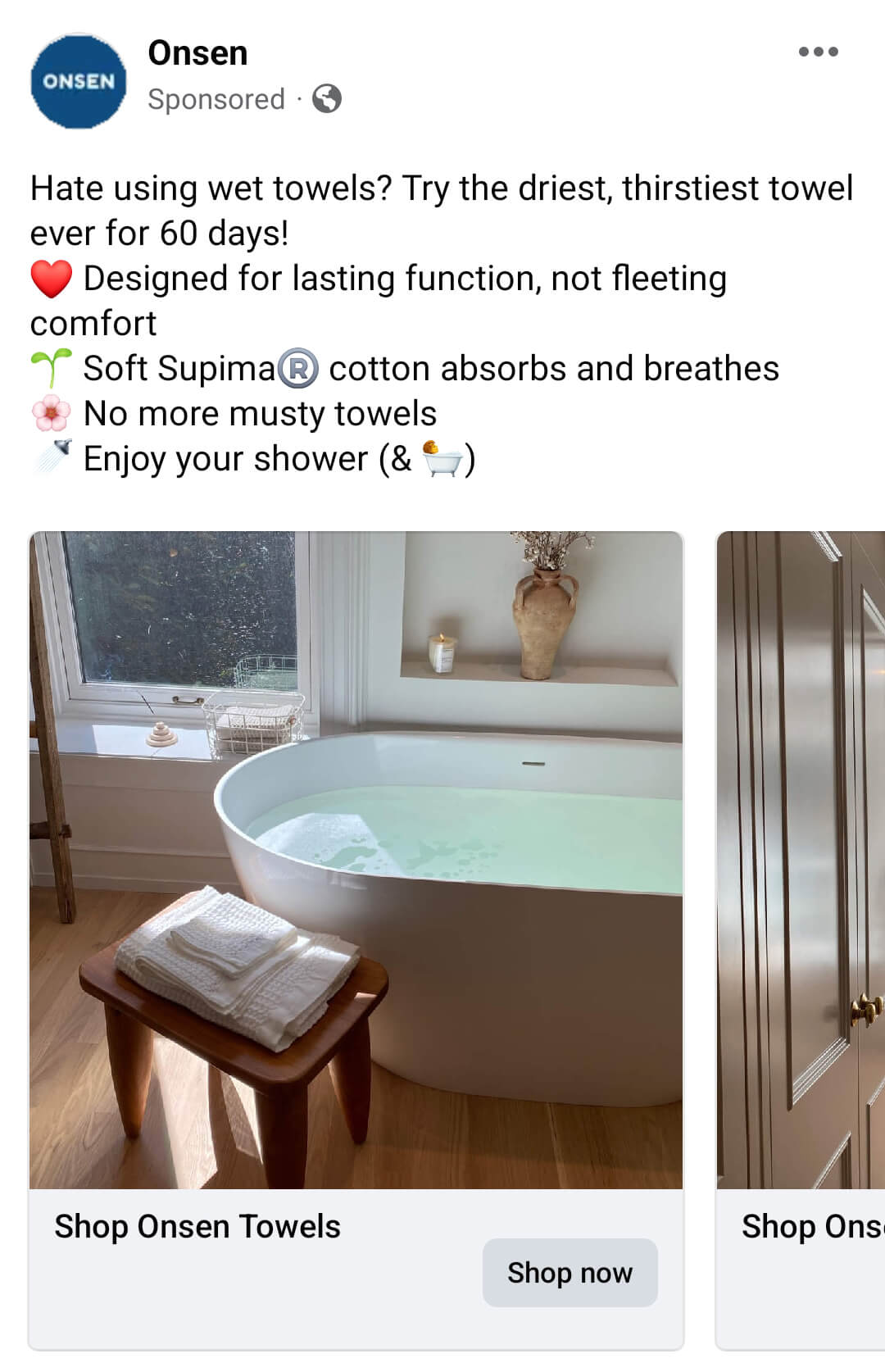
Social proof can come from many different sources. You can share the number of five-star customer reviews you’ve received or feature testimonials from real customers. You can showcase awards like @Brooklinen does in the example above. In some cases, you can even share celebrity endorsements that feature your brand or products.
In the Facebook ad below, @pompomathome shares social proof by highlighting press mentions. The ad mentions several high-profile publications that have featured the brand and are sure to resonate with the target audience.
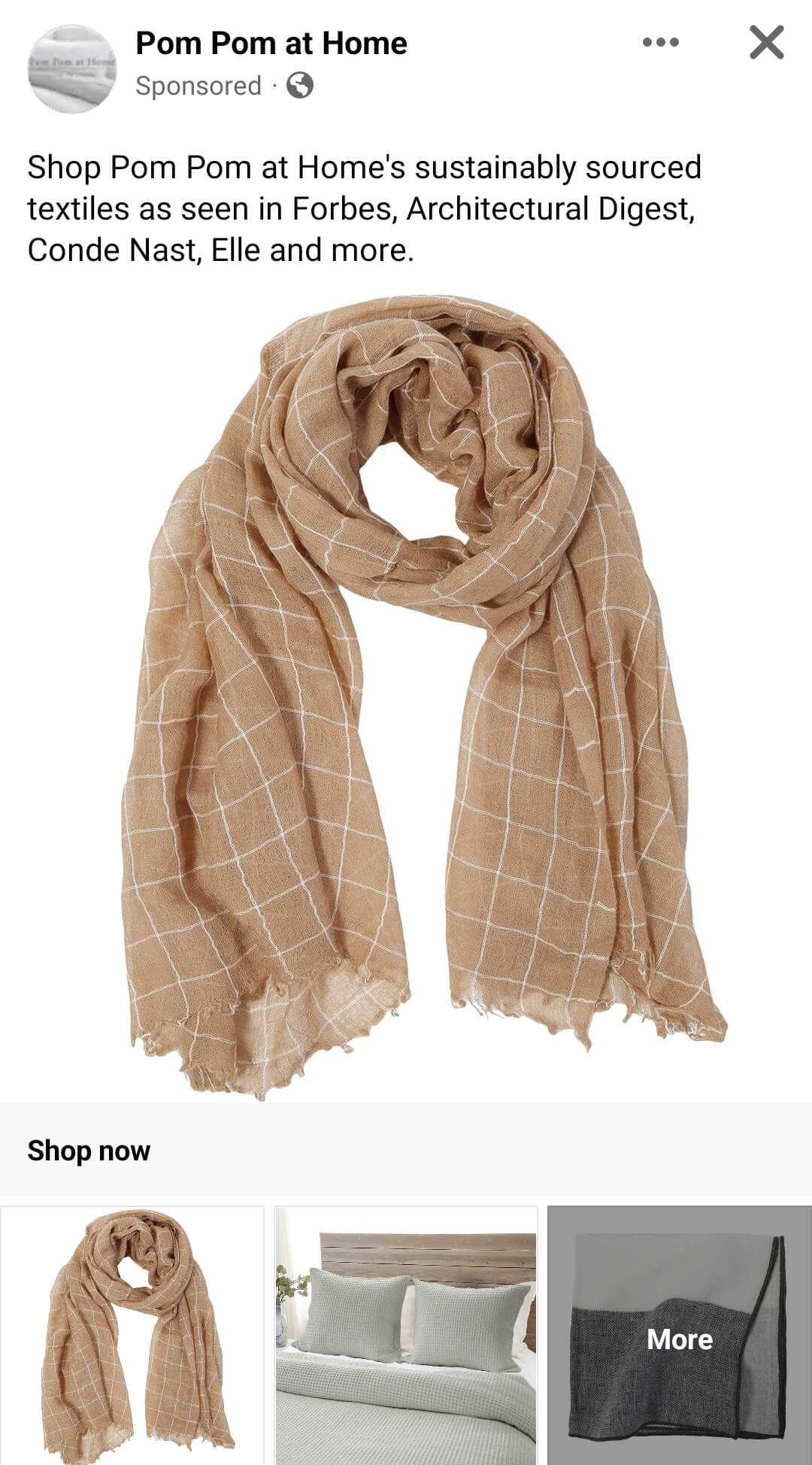
It isn’t always easy to know whether to focus on features or benefits in your ad copy. But with the Features-Advantages-Benefits (FAB) formula, you can incorporate both for maximum effect.
To use the FAB formula, begin by highlighting a feature or what your product does. Lead into the advantages or the problems it can solve for prospects. Then close with the benefits or the ultimate outcome customers can expect.
For example, the @lumecube Facebook ad below starts by highlighting what the product does: “a new type of desk light.” Then it mentions a key advantage: “makes every workday a little brighter.”
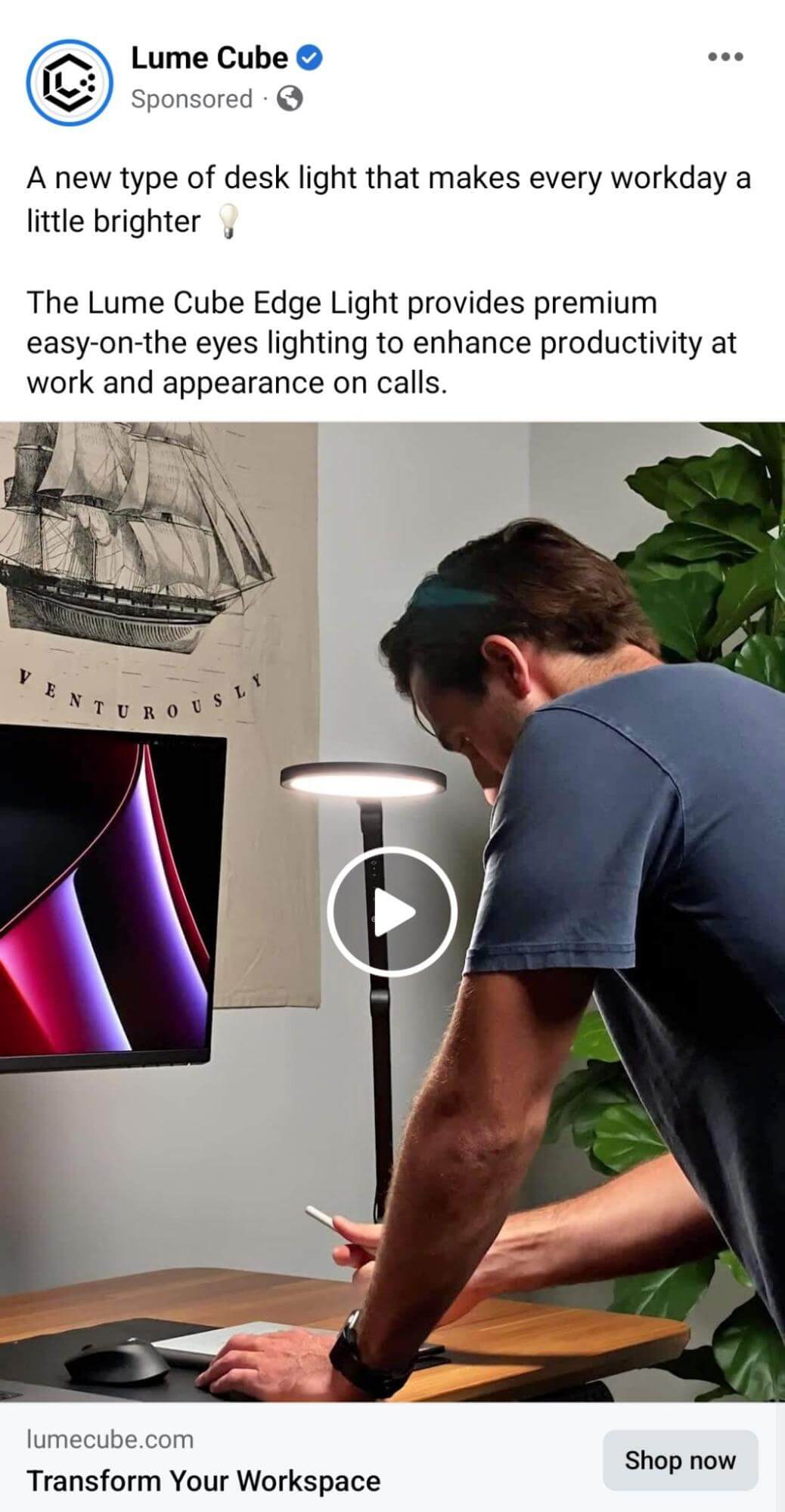
The ad copy concludes with two key benefits: “enhances productivity at work and appearance on calls.” The ad’s headline also uses a CTA that builds on the product’s main benefits: “Transform Your Workspace.”
You have a few options for identifying objections. First, review the questions your marketing team has received via social media and pinpoint the issues prospects often share. Next, connect with your sales team to learn why prospects tend not to purchase.
Then work these objections into your ad copy but don’t leave prospects hanging. Respond to each one with solutions, features, benefits, and other helpful information.
For example, the @fellowproducts Facebook ad below seamlessly addresses common objections. The copy refers to the product as “the last pour-over kettle you’ll ever need” to address potential durability concerns. The bullet points list several key features so customers can see that the product has everything they want in a pour-over kettle.
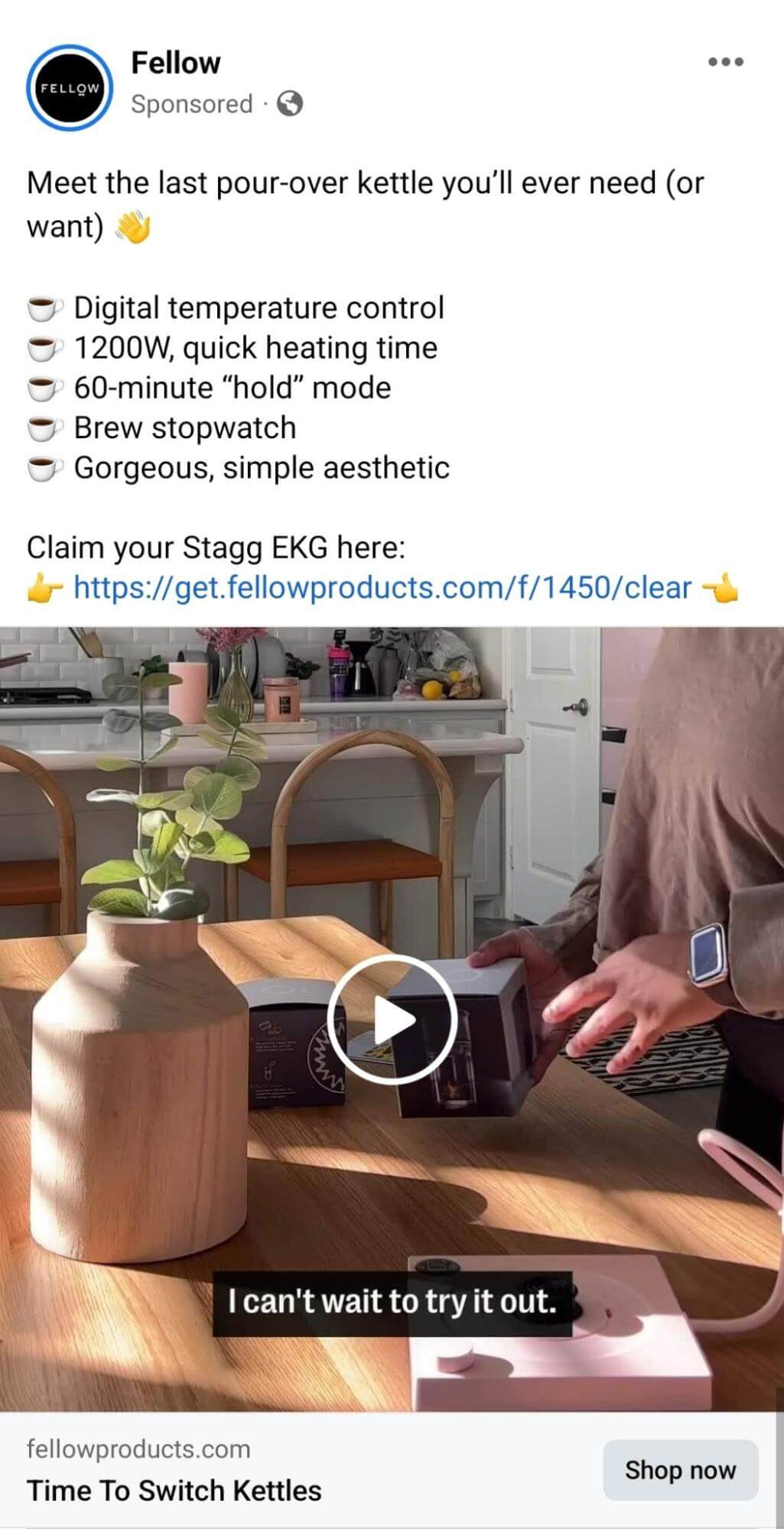
For best results, distill your Facebook ads down to one main goal. Choose the most relevant advertising objective and then use a single CTA throughout your ad copy—from the caption and creative to the description and headline.
For example, the @VitaCocoUS Facebook ad below encourages customers to join the brand’s loyalty program. The headline and primary text use different phrasing to create additional conversion opportunities, but as a whole, the ad zeroes in on a single ad objective.
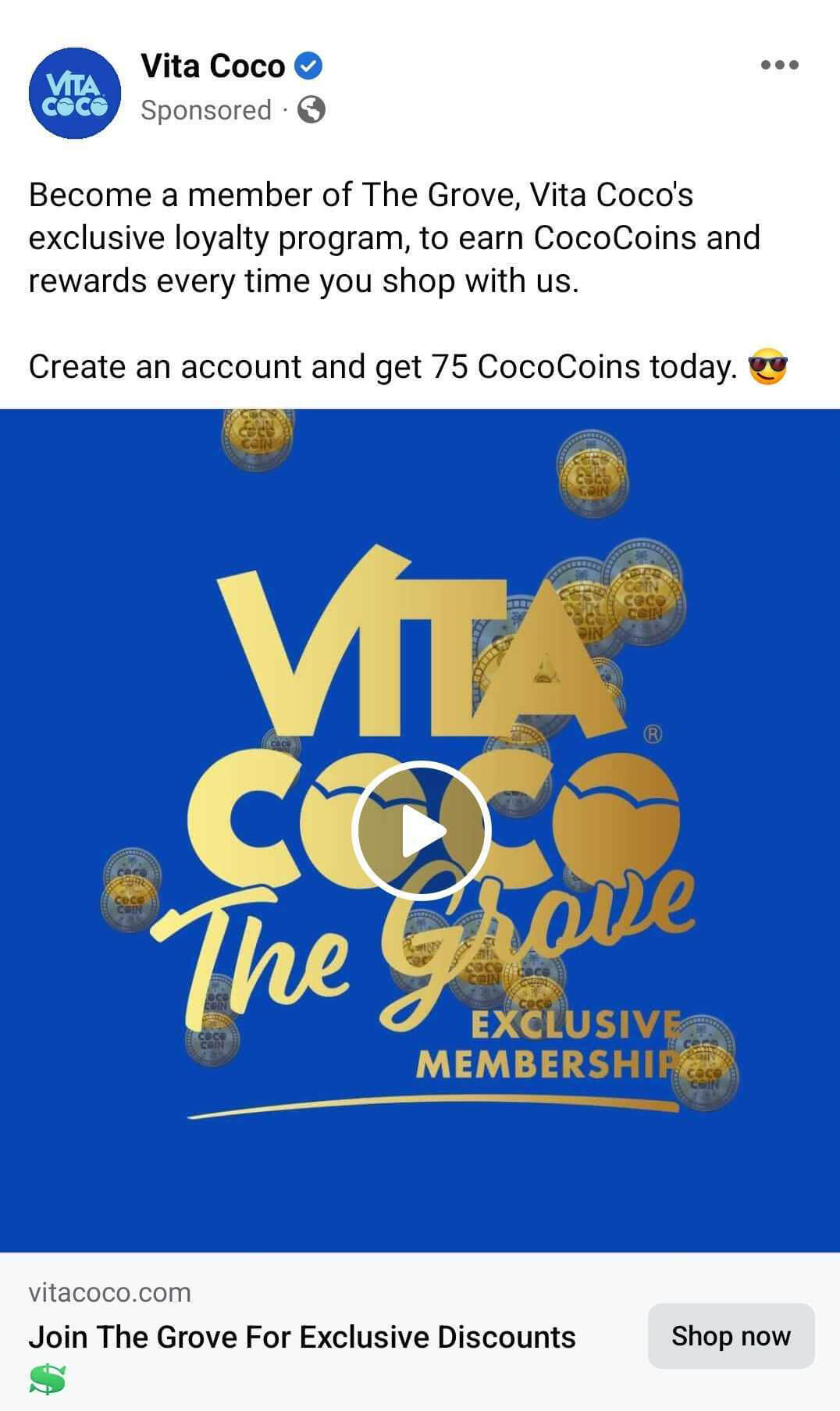
For best results, keep any text overlays in creatives short and sweet. Meta no longer prohibits extensive copy in creatives but text overlays still tend to work best when their main function is capturing attention rather than conveying lengthy messages.
For example, the @haworthinc Facebook ad below uses a simple yet eye-catching message in the creative: “Need it fast?” The ad copy reiterates this message with phrasing like “now” and “in stock and ready to ship.”

Note that even if you don’t include copy in the creative you upload to Ads Manager, the platform may add it to some placements for you. If you switch on standard enhancements at the ad level, you give Ads Manager permission to experiment with various creative options, including placing your headline on the creative.
To see how your optimized ad might look, scroll through the ad previews for each placement. Don’t love how your automatically enhanced creative looks? You can switch off standard enhancements at the ad level or adjust placements at the ad set level.
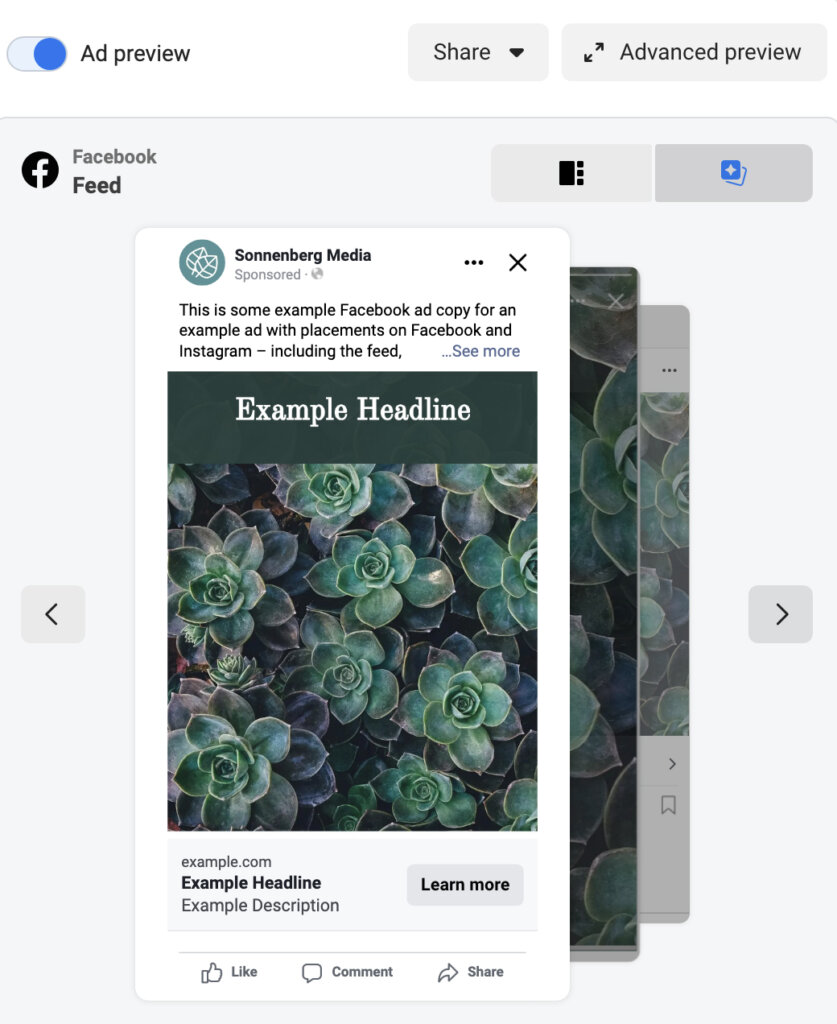
At the ad level, enter at least one option in the primary text field. Then click the plus sign to add up to four more. You can repeat this process for the headline and description fields to give Ads Manager multiple options to use.
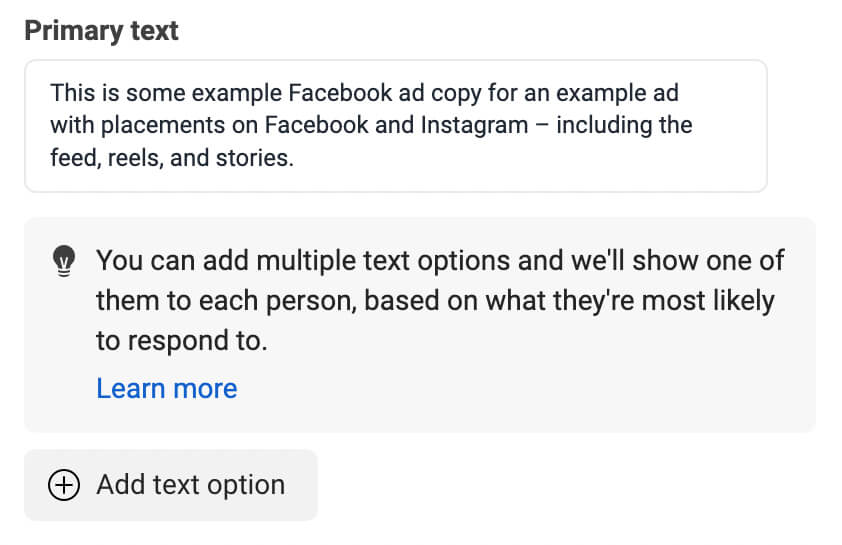
You can switch on this option manually at the ad level. If you opt for standard enhancements at this level, Optimize Text Per Person is automatically enabled.
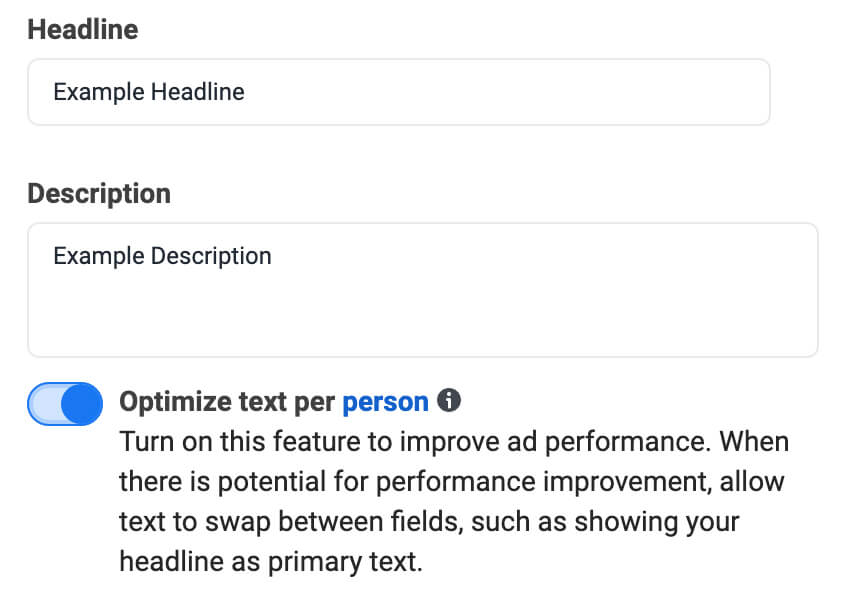
To see how your ads might look, open the Advantage+ Creative panel and enable standard enhancements. Then scroll through the previews and adjust your ad copy as necessary.
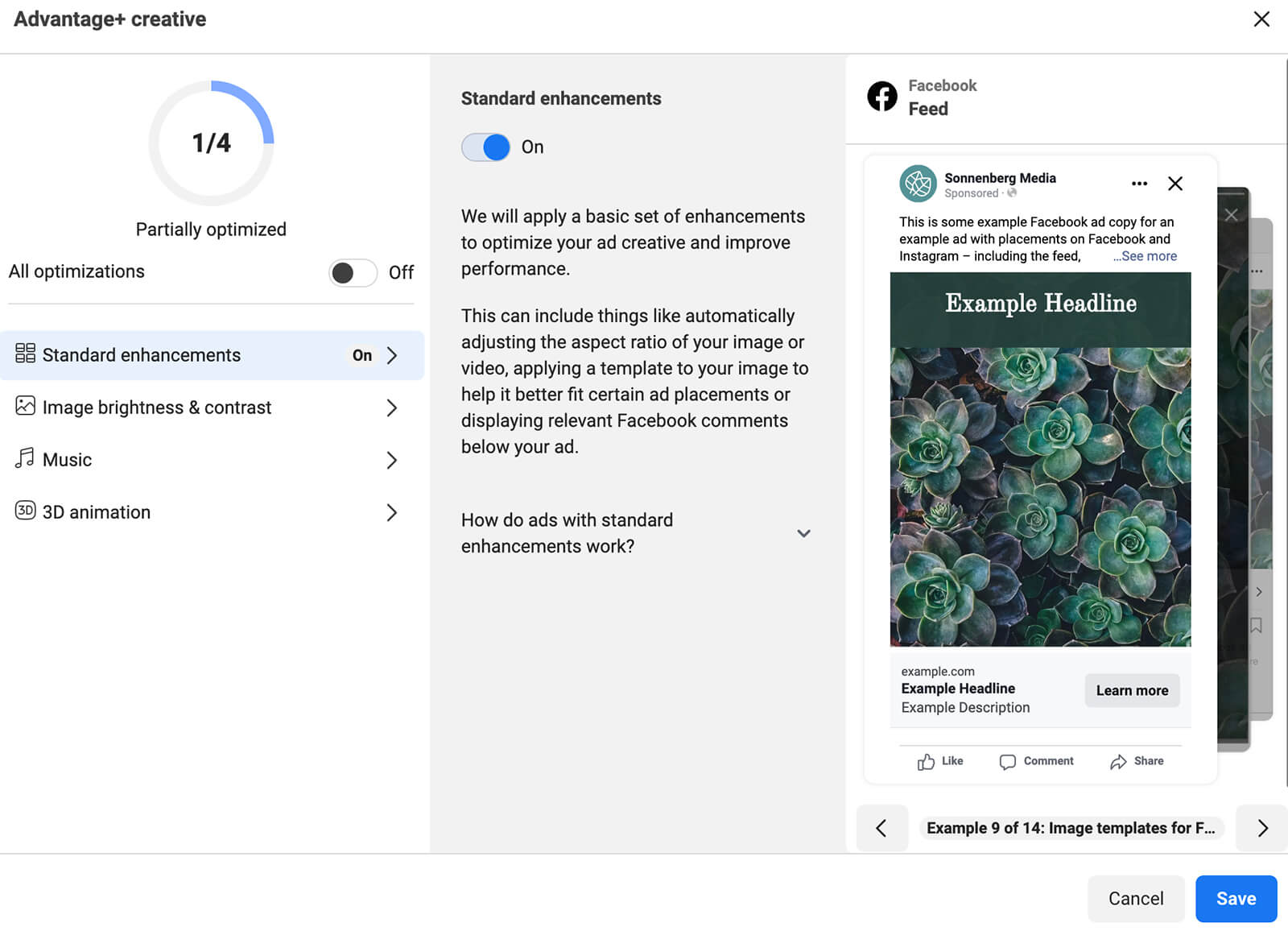
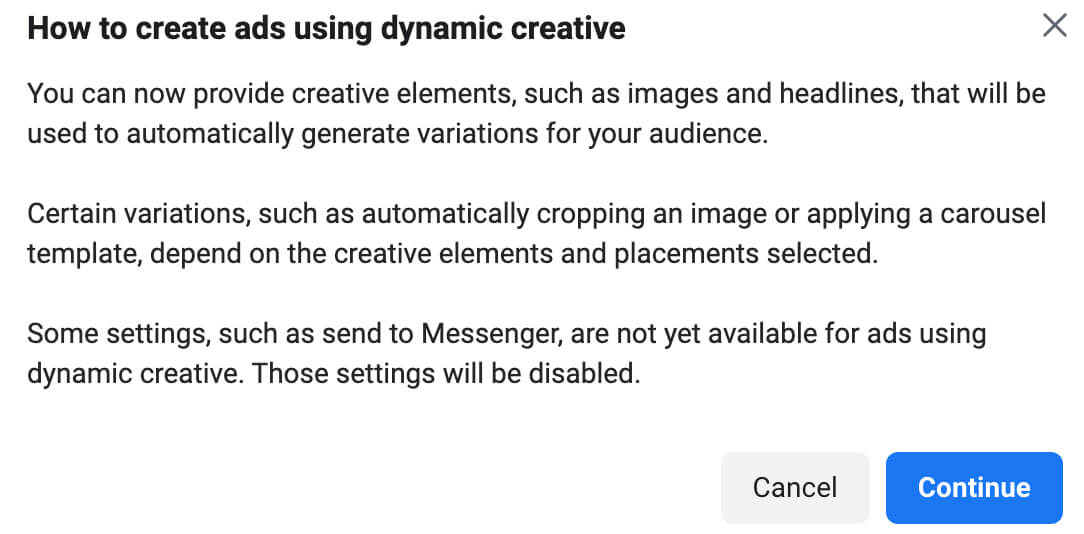
You can add multiple headlines, descriptions, and captions to give Ads Manager maximum flexibility. Keep in mind that dynamic creative doesn’t support the Optimize Text Per Person setting so it’s important to write relevant copy for each copy placement.
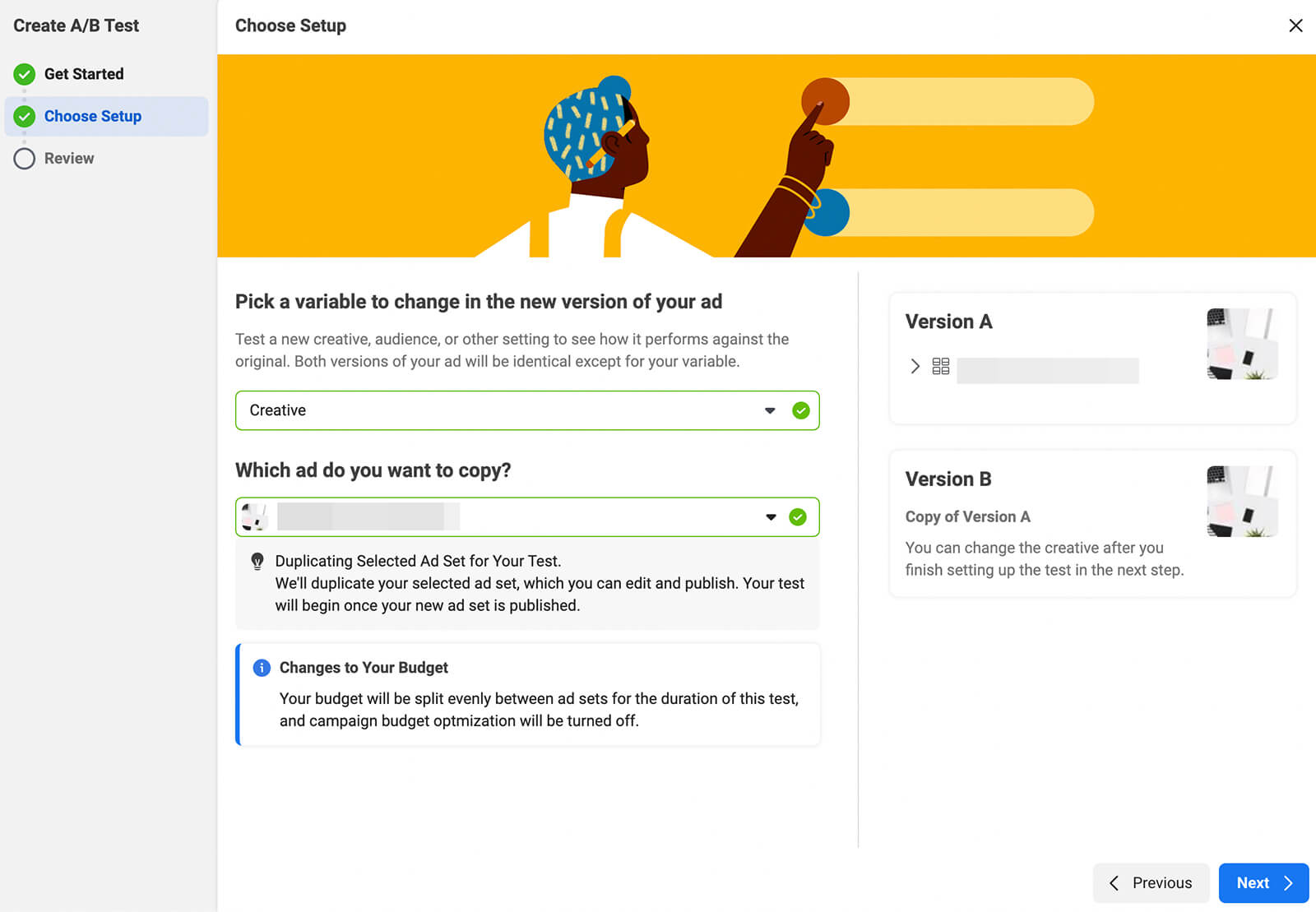
Then choose the most relevant metric to determine the winner of the A/B test. Enable the option to include upper-funnel metrics in the test report so you can collect as much helpful data as possible.
At the end of the experiment, review the results to see which version of the ad delivered the most results.
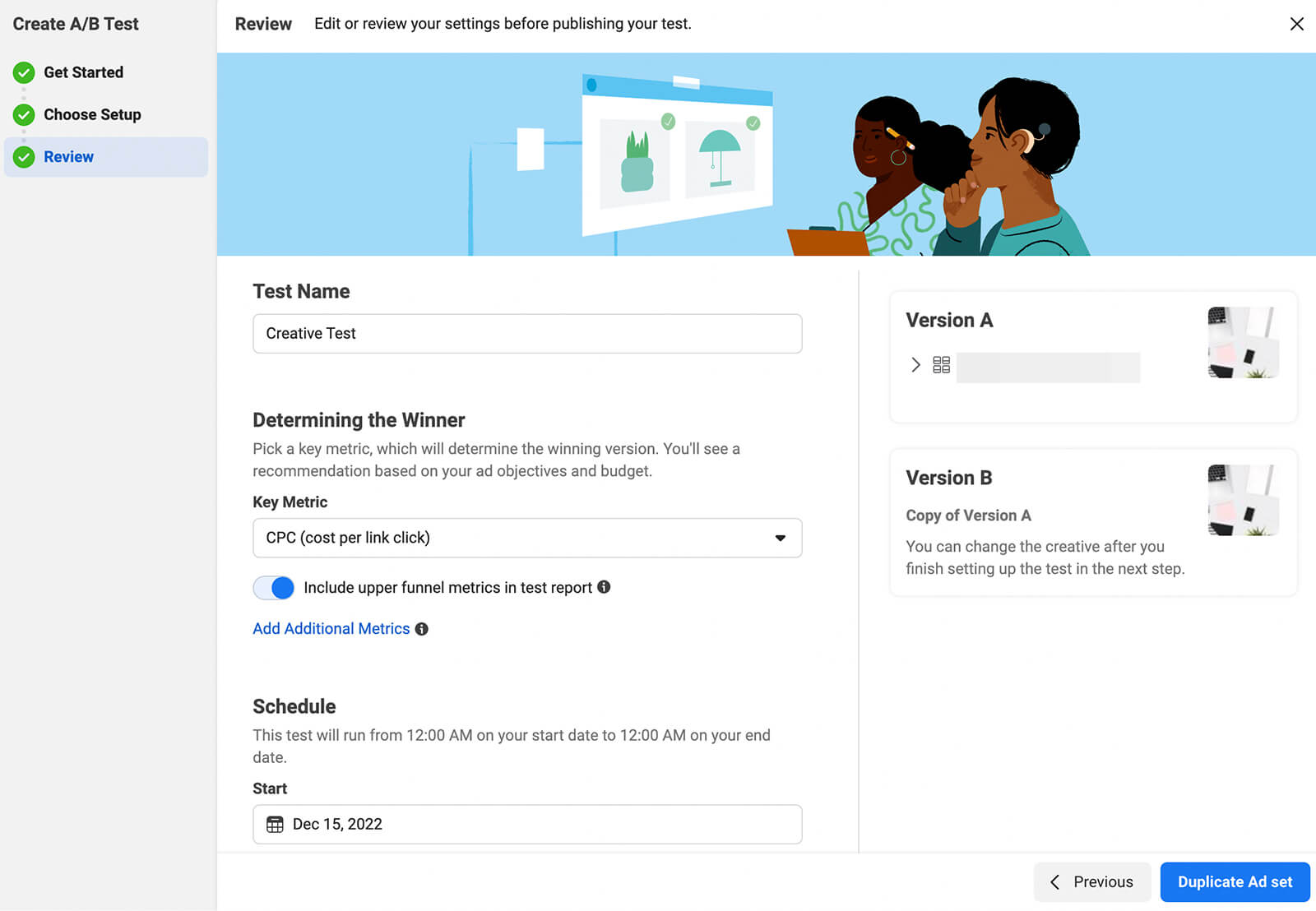
Pay attention to the upper-funnel metrics to learn what drove the most engagement and clicks and use those insights to write ads that maximize results throughout the funnel.
Do you wish your Facebook ads had a higher conversion rate? Looking for proven copywriting techniques that works?
In this article, you’ll discover how to write Facebook ads that move people to action—whether you want to generate leads, secure sales, or get prospects to take other key steps.
Technically, you could squeeze an entire blog post into the primary text section of your Facebook ad. Although Ads Manager gives you a ton of space to work with, it’s often better to keep your ad copy as concise as possible.
For most ad types, Meta recommends keeping primary text copy to 125 characters. The platform recommends keeping both the headline and the description to fewer than 30 characters.
Keep in mind that longer Facebook advertising copy gets buried behind a See More link. In fact, Facebook truncates primary text copy after about 115 characters. When you build campaigns in Ads Manager, use the ad preview to see how the copy will display for each placement. If it appears truncated, consider reworking it to display in full.
For example, the @repurpose Facebook ad below uses concise copy. Because it’s short and sweet, the primary text displays in full. To get the message across, the sustainable tableware brand uses other opportunities—including the headline and the video—to share features and CTAs.

Start With an Irresistible Hook
Between paid campaigns, suggested posts, and content from connected profiles and pages, Facebook feeds are packed with competing sources of information. Since the average Facebook user’s attention span lasts for 2.5 seconds or less, capturing interest right away is critical for conversions.With a compelling hook, you can instantly draw in Facebook users, get them to read your message, and encourage them to act. Without a hook, your ad copy doesn’t give prospects a reason to keep reading, which can cause them to scroll past before getting to the sales pitch.
So how can you write irresistible hooks for your Facebook ads? Here are some ideas to test in your ad copy:
- Tell prospects just enough of the story to make them want to learn more.
- Ask a question that you know will resonate with your target audience.
- Hint at something exclusive that they won’t be able to access otherwise.

Create a Sense of Urgency
A great hook can get prospects to read your sales pitch. But if they have all the time in the world to consider whether they want to make a purchase, go with a competitor, or buy something else instead, they may never act on your ad.To increase conversions, create a sense of urgency. By highlighting the limited timeframe for the offer or the limited quantity available, you can urge prospects to act right away, even if they didn’t necessarily intend to buy immediately.
With limited-time or limited-quantity offers, you can also instill a fear of missing out (FOMO). If prospects believe that your product or service can solve their problems or improve their quality of life, they won’t want to miss out on your offer.
For example, the @GetRocketbook Facebook ad below makes urgency front and center in its opening line, “Limited Time Offer.” To increase conversions, the ad also mentions a generous discount and a free item with a minimum purchase.

Address Customer Pain Points
Creating FOMO can absolutely get prospects to make decisions quickly, especially if they were already relatively far along in their customer journey. But what if they need more of a nudge before making a decision?With the Problem-Agitate-Solve (PAS) copywriting formula, you can start by speaking to customers’ pain points. Then once they’re listening, you can offer a solution to these common problems.
To use the PAS formula, start by asking a question that your audience is likely to find relatable. Next, agitate the problem and the related discomfort by getting more specific. Then present your solution.
In the Facebook ad below, @onsentowel starts by asking, “Hate using wet towels?” The copy leans into the problem by referencing “musty towels.” Then it offers a solution and lists some product features and benefits to guide prospects to shop.

Show Social Proof
Don’t have a limited-time or -quantity offer to advertise? Creating FOMO isn’t the only way to make prospects eager to be on board. When you share social proof, you demonstrate that others are purchasing and enjoying your products, which can cause new customers to convert.Social proof can come from many different sources. You can share the number of five-star customer reviews you’ve received or feature testimonials from real customers. You can showcase awards like @Brooklinen does in the example above. In some cases, you can even share celebrity endorsements that feature your brand or products.
In the Facebook ad below, @pompomathome shares social proof by highlighting press mentions. The ad mentions several high-profile publications that have featured the brand and are sure to resonate with the target audience.
Focus on the Benefits

It isn’t always easy to know whether to focus on features or benefits in your ad copy. But with the Features-Advantages-Benefits (FAB) formula, you can incorporate both for maximum effect.
To use the FAB formula, begin by highlighting a feature or what your product does. Lead into the advantages or the problems it can solve for prospects. Then close with the benefits or the ultimate outcome customers can expect.
For example, the @lumecube Facebook ad below starts by highlighting what the product does: “a new type of desk light.” Then it mentions a key advantage: “makes every workday a little brighter.”

The ad copy concludes with two key benefits: “enhances productivity at work and appearance on calls.” The ad’s headline also uses a CTA that builds on the product’s main benefits: “Transform Your Workspace.”
Handle Objections Seamlessly
Features, advantages, and benefits may convert a lot of prospects. But some may still have questions about your offer or reasons not to buy. If you can anticipate their objections and address them in the ad copy, you can create additional opportunities to convert.You have a few options for identifying objections. First, review the questions your marketing team has received via social media and pinpoint the issues prospects often share. Next, connect with your sales team to learn why prospects tend not to purchase.
Then work these objections into your ad copy but don’t leave prospects hanging. Respond to each one with solutions, features, benefits, and other helpful information.
For example, the @fellowproducts Facebook ad below seamlessly addresses common objections. The copy refers to the product as “the last pour-over kettle you’ll ever need” to address potential durability concerns. The bullet points list several key features so customers can see that the product has everything they want in a pour-over kettle.

Use a Single Call to Action That’s Crystal-Clear
CTAs are essential for getting prospects to take action after seeing your ads. But using more than one CTA can confuse your target audience, causing them to scroll away rather than follow your lead.For best results, distill your Facebook ads down to one main goal. Choose the most relevant advertising objective and then use a single CTA throughout your ad copy—from the caption and creative to the description and headline.
For example, the @VitaCocoUS Facebook ad below encourages customers to join the brand’s loyalty program. The headline and primary text use different phrasing to create additional conversion opportunities, but as a whole, the ad zeroes in on a single ad objective.

#2: Reiterate Messaging in the Ad Creative
No matter how compelling your copy sounds, your target audience may scroll past your ad if the creative doesn’t catch their eye. To deliver your message successfully, incorporate it into the creative. With both image and video ad formats, you can include a CTA in the creative.For best results, keep any text overlays in creatives short and sweet. Meta no longer prohibits extensive copy in creatives but text overlays still tend to work best when their main function is capturing attention rather than conveying lengthy messages.
For example, the @haworthinc Facebook ad below uses a simple yet eye-catching message in the creative: “Need it fast?” The ad copy reiterates this message with phrasing like “now” and “in stock and ready to ship.”

Note that even if you don’t include copy in the creative you upload to Ads Manager, the platform may add it to some placements for you. If you switch on standard enhancements at the ad level, you give Ads Manager permission to experiment with various creative options, including placing your headline on the creative.
To see how your optimized ad might look, scroll through the ad previews for each placement. Don’t love how your automatically enhanced creative looks? You can switch off standard enhancements at the ad level or adjust placements at the ad set level.

#3: Let Facebook Personalize and Optimize Your Facebook Ads
One way to fine-tune your ad copy for various users is to leverage Ads Manager’s built-in optimization tools. Because these tools are designed to deliver the optimal ad to each user, they can be great for conversions. But keep in mind that Ads Manager reports don’t offer breakdowns for these iterations so they aren’t the best for understanding your audience.Write Multiple Copy Options
Not sure which headline or hook will drive the most conversions? You can test a few different ideas in a single ad.At the ad level, enter at least one option in the primary text field. Then click the plus sign to add up to four more. You can repeat this process for the headline and description fields to give Ads Manager multiple options to use.

Optimize Text Per Person
Can’t decide what ad copy to use in the headline or description field? With Ads Manager’s Optimize Text Per Person feature, the platform can automatically swap primary text, headlines, and descriptions to improve performance. This option is particularly helpful for testing concise copy since the headline and description fields are so limited.You can switch on this option manually at the ad level. If you opt for standard enhancements at this level, Optimize Text Per Person is automatically enabled.

Advantage+ Creative
Most of the optimizations available with Advantage+ Creative apply to the creative only. But if you enable standard enhancements, Ads Manager may incorporate some of your copy into the creative.To see how your ads might look, open the Advantage+ Creative panel and enable standard enhancements. Then scroll through the previews and adjust your ad copy as necessary.

Dynamic Creative
For maximum optimization, enable the Dynamic Creative option at the ad set level. This tool automatically develops iterations of your ad based on the creatives and copy you provide.
You can add multiple headlines, descriptions, and captions to give Ads Manager maximum flexibility. Keep in mind that dynamic creative doesn’t support the Optimize Text Per Person setting so it’s important to write relevant copy for each copy placement.
Use A/B Testing to Reveal High-Performing Facebook Ads Elements
When you want concrete results rather than automated optimizations, use Ads Manager’s A/B Testing tool to test different ads against each other instead. Start by selecting an ad to use as a control. Then pick another active ad to test against it or make a copy of the control and edit it to test specific elements. For more accurate results, always test one element at a time.
Then choose the most relevant metric to determine the winner of the A/B test. Enable the option to include upper-funnel metrics in the test report so you can collect as much helpful data as possible.
At the end of the experiment, review the results to see which version of the ad delivered the most results.

Pay attention to the upper-funnel metrics to learn what drove the most engagement and clicks and use those insights to write ads that maximize results throughout the funnel.



